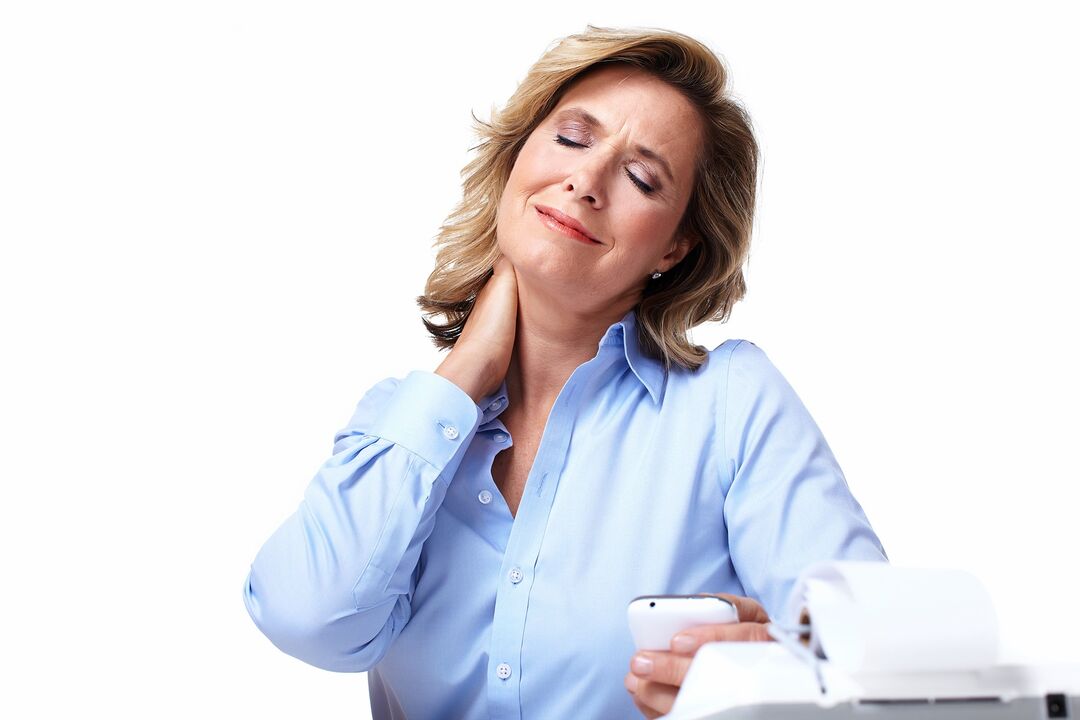Osteochondrosis is a disease that destroys the intervertebral discs and joints of the spine. Of all five parts of the spine, anyone can be affected by the disease, but it is the manifestations and symptoms of osteochondrosis of the cervical spine that cause people the most problems. This is due to the large number of nerve fibers and endings, as well as blood vessels that supply the brain and run through the neck.

This area of the spine is the most flexible. It is thanks to the neck that a person can rotate and tilt their head. Constant stress on the neck region contributes to degenerative changes in its structure and the development of osteochondrosis.
Who is affected by the disease
Most often, the disease develops and begins to manifest itself in twenty-five to thirty years, since a person has forced a long stay in a static and uncomfortable position. First of all, it affects office workers, drivers, operators of various types of equipment. Often the disease manifests itself in athletes as a result of training, or vice versa, with its abrupt cessation.

The main causes of osteochondrosis in the cervical and thoracic spine are incorrect posture, lack of exercise, heredity, an improperly organized workplace or an uncomfortable bed. Lifting weights also contributes to the occurrence of this disease, since in this process microtraumas are possible, contributing to dystrophic changes in the cartilage and bone tissue of the spine.
Stages of development of osteochondrosis of the spine
- Intervertebral discs are just beginning to collapse, losing moisture and elasticity. This process can take a long time. The phase is characterized by instability.
- It is characterized by bulging (bulging) of the intervertebral discs. The intervertebral spaces are reduced due to the destruction of the fibrous ring of the intervertebral disc and a decrease in its height. Pain can occur due to pinching of the nerve roots by the approaching vertebrae and protruding intervertebral discs.
- There is a complete destruction of the fibrous ring and, as a result, the formation of intervertebral hernias. The spine is severely deformed.
- This stage is the most difficult, as almost every movement causes pain. Bony growths appear, they connect the vertebrae and limit mobility. Such growths can lead to disabilities.
Particular signs of cervical osteochondrosis
The blood vessels that supply the brain are primarily located in a person's neck, so many of the signs of the disease are associated with impaired blood flow to the brain.

- So, here are the signs of osteochondrosis of the cervical spine that you notice that you need to see a doctor:
- severe, persistent pain in the neck and head that extends to the eyes and ears;
- pains in arms that get worse with every effort;
- difficulties in the movements of the fingers and hands, a violation of their sensitivity;
- neck muscle tension;
- when turning and tilting the head, the appearance of neck pain;
- the appearance of throbbing pain in the neck and neck;
- the appearance of dizziness when turning the head (including from fainting), tinnitus;
- numbness of tongue, blurred vision and hearing;
- Pain in the heart that is not cured by taking the appropriate medication;
- nausea, instability of blood pressure;
- sore throat, difficulty swallowing;
- feel shortness of breath.
symptoms of pathology
The manifestation of symptoms of osteochondrosis of the cervical spine can be associated with a malfunction of the following organs and systems in the patient's body:
- Compression and disruption of the spinal cord in the spinal canal. Such symptoms are rare and can only appear in very severe cases;
- Changes in the peripheral nervous system, the cause of which is compression of the nerve roots adjacent to the affected vertebrae;
- Violation of the blood supply to the brain.
When diagnosing this disease, the doctor pays attention to the presence of a number of symptoms. Their appearance depends on which part of the spine has been affected by the disease.
Cardiac syndrome in osteochondrosis of the cervical spine
The signs of cardiac syndrome in osteochondrosis are similar to angina, this is due to irritation of the roots of the pectoralis major muscle or phrenic nerve. The resulting pain can last up to several hours, and when you sneeze, a sharp turn of your head, the cough increases in intensity.
Tachycardia and extrasystoles may appear, which do not go away with the use of appropriate drugs, and the cardiogram does not show any abnormalities.
stimulus reflex syndromes
This group of syndromes is characterized by severe neck pain that is aggravated by movement, coughing, turning the head, and sneezing. It can radiate to the shoulder or chest.
radicular syndrome
This syndrome manifests itself when the cervical nerve is pinched. It is characterized by the spread of pain from the neck through the shoulder blades and forearms to the fingers. Perhaps the appearance of numbness and goosebumps in the back of the head, neck, shoulder area, hands.
vertebral artery syndrome
This syndrome, caused by compression of the vertebral artery responsible for blood supply to the brain, is characterized by the appearance of a sharp or throbbing headache, spreading to the occiput, forehead and temples. Perhaps the appearance of nausea, loss of orientation, the appearance of impaired hearing, poor eyesight, fainting.
A person who has noticed the appearance of the above signs of cervical osteochondrosis should immediately consult a doctor.
It must be remembered that treatment started at an early stage of the disease is most effective. It will help stop the disease and continue living a full life.
Today, medicine offers various methods of treating osteochondrosis, allows you to slow down or stop the destruction of the spine, and allows the patient to live a long life without pain.
Proper nutrition, an active lifestyle, regular exercise, gymnastics and stretching of the spine will allow you not to remember such a problem as cervical osteochondrosis in the future.
















































